Andy Kamenetzky hosted a podcast with myself and ESPNLosAngeles.com baseball beat writers Tony Jackson and Mark Saxon to compare and contrast the state of the Dodgers and Angels, who both head into today’s final day with 79-82 records. Have a listen …
Category: Status report (Page 10 of 10)
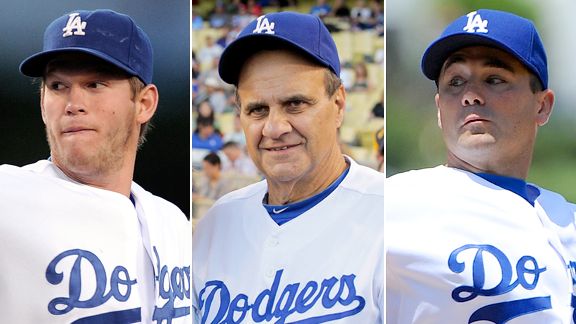 Getty ImagesDodgers such as Clayton Kershaw, Joe Torre and Ted Lilly have targets to shoot for – or avoid.
Getty ImagesDodgers such as Clayton Kershaw, Joe Torre and Ted Lilly have targets to shoot for – or avoid.Need something to keep your interest in the Dodgers over the season’s final six games? Here are 10 postcards from the edge of your seat …
1) Clayton Kershaw’s sub-3.00 ERA
Kershaw figures to make one more start this season, Wednesday at Colorado – a tough locale for keeping his current 2.91 ERA below 3.00 for the second year in a row. This is complicated by the fact that a few scenarios put Kershaw’s final ERA at 2.995 or 2.996, which technically keeps him below 3.00 but won’t do the trick for those who don’t take the decimal places out that far. Here’s how many runs Kershaw can allow, based on how many innings he throws:
| Innings Wednesday | Max runs allowable to keep ERA below 3.000 | Max runs allowable to keep ERA below 2.995 |
|---|---|---|
| 1 | 2 | 2 |
| 2 | 2 | 2 |
| 3 | 3 | 2 |
| 4 | 3 | 3 |
| 5 | 3 | 3 |
| 6 | 4 | 3 |
| 7 | 4 | 4 |
| 8 | 4 | 4 |
| 9 | 5 | 4 |
Those of you interested in fractions of innings, you’ll have to remain in suspense.
2) Kershaw’s pursuit of the Dodger pitcher sacrifice bunt record
Is anything really more important than this? Kershaw has 18 this season, with only Orel Hershiser (19) ahead of him.
3) Team home run leader
Media guide cover boys Matt Kemp and Andre Ethier are tied at 23. Who will win bragging rights, which will come in necessary next year when Kershaw figures to be the media guy cover boy?
4) Team RBI leader
Despite having only 21 RBI since the All-Star break, James Loney (84) is still trying to hold off Ethier (79) and Kemp (77) for the title. Loney’s cause might have been aided by John Lindsey’s injury.
5) Joe Torre’s 2,000th loss
The Dodgers’ loss Sunday was Torre’s 1,996th as a manager. The team needs to go 3-3 to keep him below two grand.
6) .300 club
The Dodgers will not have a qualified hitter (minimum 502 plate appearances) bat above .300 this season. So let’s turn to the unqualified! Kenley Jansen (1.000) and Manny Ramirez (.311) are locks, but Trent Oeltjen (.333), Rafael Furcal (.298), Jamey Carroll (.292) and Jay Gibbons (.288) are in the running. And why stop there? A.J. Ellis, Rod Barajas and pitchers from hither to yon could also end up at .300 with a hot final week.
7) Ted Lilly’s HR/BB ratio
Lilly enters the final week with 12 homers and 11 walks allowed as a Dodger. Don Newcombe (1958) and Terry Mulholland (2002) are the only Dodgers to allow more homers than walks in a season, minimum 10 homers allowed.
8) Hustleful but homerless
Jamey Carroll enters the final week of the season without a home run to his credit in 408 plate appearances. Carroll has homered in each of his past four seasons, but can he make it five? Carroll is currently tied for 2,725th place on baseball’s all-time home run list with 12.
9) September Mourn
The worst September (and October) in Los Angeles Dodger history was the 10-20 performance by the woeful 1992 team. The 2010 Dodgers are 7-16 in September, so if they lose at least four of their final six games, they’ll take the crown.
10) Lowest of the low
The worst teams in baseball since the All-Star break:
24-43, .358 Kansas City
24-43, .358 Seattle
25-42, .373 Pittsburgh
26-42, .382 Los Angeles
28-39, .418 New York Mets
28-39, .418 Washington
Yes, the Dodgers can be that team.
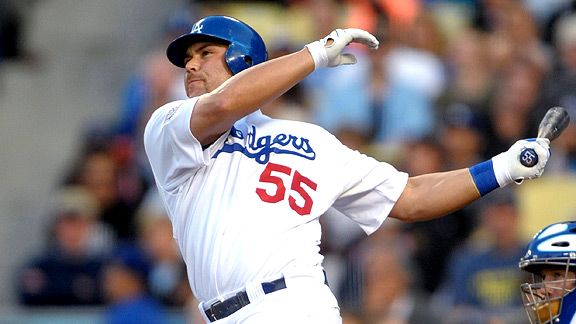
Kirby Lee/US PresswireRussell Martin: Just one of the many questions the Dodgers face this winter.
The Dodger roster heading into the 2010-11 offseason, and I don’t say this lightly, is a mess.
It’s not a hopeless mess. But it is a mess, and it’s going to take some skill from the crew in charge to clean up. It’s a goop of oil and water, an unsightly combination of having to fill holes while also figuring out which rising salaries to jettison and which to risk holding onto.
Oh, and when the 2010 season ends, the No. 5 starter on the 40-man roster, at least by major-league experience, will be someone who hasn’t pitched in a professional game in four months: Scott Elbert.
The Dodgers have one absolute jewel on the team: Clayton Kershaw. The team’s top player won’t be arbitration eligible for one more year and only figures to earn approximately $500,000 in 2011.
Then, there are a few players whose higher salaries the Dodgers won’t mind paying. Chad Billingsley, who will command somewhere in the neighborhood of $6 million, knocked down many of the questions others had about him with a resurgent 2010 season. Hong-Chih Kuo will draw low seven figures, and after the way he has persevered and performed, no one should begrudge him. Kenley Jansen will make people swoon, and only receive the major-league minimum pay and meal money in return.
So much for the good news. Now, the concerns:
- Rafael Furcal surely remains talented, but the Dodgers have $12 million going to a player who has averaged fewer than 100 games per year since 2008.
- Slumping reliever Jonathan Broxton’s final season before free agency is tagged with a $7 million salary.
- Coming off an injury that ended his second straight disappointing year, arbitration-eligible Russell Martin would also get as much as $7 million if the Dodgers don’t non-tender him.
- Andre Ethier looked like an MVP at the start of the year; by the end, his $9.25 million 2011 salary for an outfielder who struggles against lefties didn’t seem like quite as much of a bargain.
- Lightning Rod Award-winning outfielder Matt Kemp has $6.95 million coming next year.
- Casey Blake, game but aging, gets $5.25 million in the final chapter of his three-year deal.
- By now, James Loney should have developed enough that the $4.5 million he is projected to earn next year should have seemed closer to a bargain than a burden, but his second-half disappearance hasn’t helped matters.
- Incumbent second baseman Ryan Theriot and his sub-.700 OPS will bring home about $3.5 million if the Dodgers hang onto him.
In sum, that’s about $55 million committed to a series of question marks, some small, some large. In addition, Los Angeles owes approximately $17 million of its 2011 budget to (swallow hard) Manny Ramirez, Juan Pierre, Andruw Jones and Jason Schmidt — the price for turning past mistakes into the playoff teams of the previous two years.
Overall, the Dodgers on paper have close to $100 million — a figure that might well be at or above their budget limit — committed before they make a single offseason move.
Now, all is not lost. The Dodgers can and probably will gain roughly $12 million in breathing room if and when they bid farewell to George Sherrill, Octavio Dotel, Scott Podsednik and Brad Ausmus (who has said he will retire). Meanwhile, free agents Jay Gibbons and Rod Barajas should start to help shore up the bench for under $2 million combined. And it should be noted that not all of the above question marks will have negative answers.
Nevertheless, that still leaves the Dodgers at about $90 million in payroll, with John Ely as their No. 3 starter and serious questions about most of their offense. As shaky as their lineup now looks, and however aggressive the Dodgers might want to be with the latest crop of prospects, the Dodgers absolutely have to add at least two more starters, whether through free agency or trade, whether Ted Lilly, Hiroki Kuroda or outsiders.
It’s for this reason that unless the team salary budget goes up, the Dodgers almost certainly will trade or non-tender a 2011 contract to at least one from the group of Broxton, Kemp, Ethier, Loney and Martin. Loney, because he has the lowest salary, might be most likely to stay – he’s finishing the year as a disappointment at first base, but he’s not finishing the year alone as a disappointment. In any case, all of them have something to offer other teams that might be, as hard as it is for some to digest, more willing to spend than the Dodgers are.
An Ethier trade would be a shock, for example, much more than a Kemp trade, but who can say it’s out of the question now?
However this plays out, the Dodgers may well bring back many of the same players next year who boosted them to National League Championship Series appearances in 2008-09 and sunk them in 2010. In one respect, nothing will have changed: You’re always hoping players move forward, like Kershaw and Billingsley, and not backward, like Kemp and Loney and Broxton and Martin and so on. Good does sometimes follow bad, after all. But still, it’s going to be a nervous offseason for a lot of us.
Sure, BP had it tougher. But as cleanup goes, this is as thick a goop as Chavez Ravine has seen in quite some time.

Scott Wachter/Icon SMIRonald Belisario: 2.04 ERA in 2009, 5.32 ERA in 2010.
It wasn’t even a headline. It was just a little item in Tony Jackson’s Dodger notebook from the earliest days of Spring Training, appearing below the day’s top news: “Blake shaves signature beard.”
Dodgers reliever Ronald Belisario will be late to spring training for the second season in a row because of visa problems in his native Venezuela …
There was no indication of how late Belisario would be, or much reason to think it would affect his 2010 season. And it was but one pitcher in a deep Dodger bullpen, one of the best in baseball the previous year.
The Dodgers had other things to worry about. Who would be their fifth starter? What condition would Manny Ramirez be in? Would Russell Martin and Chad Billingsley come back from disappointment? How would the ownership strife affect the team? So Belisario’s going to be a little late. So what?
But as it turned out, Belisario’s visa problem, which was never completely explained, was a pinprick in the Dodger life-raft. The other concerns didn’t completely go away, but strangely, it was with Belisario’s absence that the air slowly began leaking out of the 2010 Dodger season.
Without Belisario, the Dodgers weren’t as prepared for George Sherrill to misplace his mechanics or for Hong-Chih Kuo to begin the season with soreness in his left elbow. It put an extra strain on second-year reliever Ramon Troncoso, and compelled the Dodgers to keep both Russ and Ramon Ortiz on their Opening Day roster. Four times in the team’s first eight games, Dodger relievers ended up with an L next to their names in the box score. In a year that begin with promise but also uncertainty, the Dodger bullpen was supposed to be the anchor of the two-time defending National League West champions. Instead, it was the first sign of the unraveling.
And as it turned out, there was plenty to unravel. Among the many other fraying threads of a year gone awry were these:
Garret Anderson: Remember when Brian Giles and Doug Mientkiewicz were competing for the role of top left-handed pinch-hitter? Each came with health concerns, so come March, the Dodgers decided to take a look at Anderson, perhaps the most costly look since Lot’s wife checked her rear-view mirror. Anderson had the lowest adjusted OPS (29) of any Dodger with at least 150 plate appearances since Maury Wills in 1972 and second-lowest of any grown man in a Dodger uniform in 99 years.
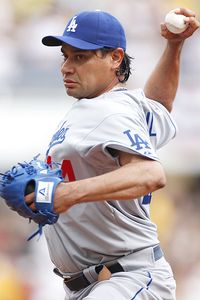
The Dodgers got about six productive weeks out of Vicente Padilla in 2010.
Sour start: Inviting speculation that he was implicitly criticizing the state of the team’s pitching, Joe Torre passed over Hiroki Kuroda to give the first pitch of the season to Vicente Padilla. The Dodgers subsequently began the season on a grim note, with Pittsburgh’s Garret Jones homering in his first two at-bats against Padilla en-route to an 11-5 pounding of the Dodgers. Pittsburgh began the season 2-0 over Los Angeles; the Pirates are 45-92 since.
Bullpen bottoms out early: Torre used Jonathan Broxton in the ninth inning of the Dodgers’ third and fourth games of the season, with leads of eight and six runs. In the fifth game of the season, Troncoso and Sherrill were asked to protect a two-run lead in the ninth, and failed. This, as it turned out, was not an aberration.
Death to flying things: Seemingly quelling fears about the back of the Dodger starting rotation, Charlie Haeger struck out 12 in six innings during his first start of the season. But one out before Haeger’s outing was over, Matt Kemp bobbled and dropped a fly ball, leading to an unearned run that cut the Dodgers’ lead to 5-4 and setting in motion a season Kemp is already trying to forget. Jeff Weaver gave up two more runs in the seventh inning, and the Dodgers came home from their first road trip of the season 2-4.
Manny needing medical: With a .500 on-base percentage and .619 slugging percentage, Ramirez heads to the disabled list for the first of three times in 2010 with a right calf strain. In the 13 games he had played to that point, the Dodgers had scored 93 runs.
Many needing medical: A day later, the struggling Padilla went on the DL. A week later, it was Rafael Furcal. Haeger, in something of a mercy killing, landed on injured reserve following his eight-strike, five-run start against Colorado. And then just after Ramirez returned, a broken pinky sidelined Andre Ethier and halted his MVP-caliber start to the season.
Lima’s time: It had no bearing on the Dodgers’ playoff hopes, but the passing of Jose Lima can’t go unremarked upon when talking about things gone wrong.
Elbert’s Elba: Scott Elbert, the Dodgers’ top pitching prospect at the start of the year, gets called up, walks three in two-thirds of an inning, and isn’t heard from again.
Broxton’s season turns: With the Dodgers continuing to ache for reliable setup men, the All-Star closer’s season 180s with a 48-pitch nightmare against the Yankees.
Another Belisario mystery: Just when he had righted himself on the field, Belisario disappears to the restricted list for a month.
The end of Elymania: The shot in the arm provided by rookie John Ely ricochets on the Dodgers when he posts a 7.49 ERA in his final seven starts before being sent back to Albuquerque.
Fruitless acquisitions: The Dodgers trade Blake DeWitt, James McDonald, Lucas May, Elisaul Pimentel, Brett Wallach, Kyle Smit and Andrew Lambo for Ted Lilly, Octavio Dotel, Ryan Theriot and Scott Podsednik – and then go 14-15 in August and 1-6 to start September.

The Dodgers are more than a hair out of the playoff chase.
Absent offense: The team’s second-half OPS is .647. No Dodger with more than 50 plate appearances has an OPS over .750 since the All-Star break.
More injuries: Furcal and Martin succumb again in August, Martin for the season.
To shield themselves from these falling rocks, the Dodgers had the sustained excellence of Clayton Kershaw, Kuroda and Kuo, the comeback of Billingsley, the valuable off-the-bench contributions by Jamey Carroll, and occasional hot streaks by various other players from time to time, from Ramirez, Ethier, Furcal and even Kemp (in April) to Carlos Monasterios, Kenley Jansen, Ely, Padilla and Lilly. There was the nine-game winning streak in May. There was even a walkoff balk.
It wasn’t enough, not nearly. The Dodgers didn’t have the kind of protection they needed against so much pummeling. Too many expectations went unmet. In the starting lineup, you can’t find a single player who didn’t take a step back in performance and/or health.
Despite the McCourts, the Dodgers had a contender on paper. But that paper got shredded, much like Ronald Belisario’s visa application.
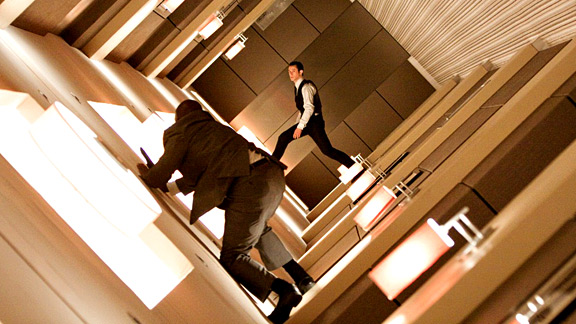
Warner Bros. PicturesUpside down, boy you turn me, inside out …
Each of the following passages is rooted in something real. And yet each reality offers a mystery.
I just had so many different thoughts, and this is me trying (and, as you’ll see, mostly failing) to make sense of them. But whether I make sense of them or not, 10 days from now, on July 31, baseball’s no-waivers-required trade deadline, we get the kick.
* * *
After a night like Tuesday – not to mention confirmation that Manny Ramirez will be out for a while – this Dodger team might seem to have a cloud of doom over it.
It’s a Dodger team that hasn’t been very healthy, hasn’t been (except for a short stretch in May) very lucky, hasn’t been very deep and lately hasn’t been very good.
Rafael Furcal has exceeded expectations, as has Hong-Chih Kuo for all of 30 of the team’s 840 innings pitched this season. Andre Ethier is a little better than expected, though not as much since early May. Same with Jamey Carroll. And after that, who?
The issue is not whether the Dodgers are out of contention. They’re not. They could be leading the wild card race inside of a week. And unless you’ve completely ruled out the possibility of the upstart Padres having their own problems, the NL West is wide open.
We’ve all seen this show before – twice in recent years, in fact. In 2006 and 2008, the Dodgers had tremendous swoons, only to recover from them.
Each time, they got help at the trade deadline – without blowing up the team.
So, what now?
* * *
Well, it’s not just about now.
At the end of this season, starting pitchers Hiroki Kuroda and Vicente Padilla become free agents. So does outfielder Manny Ramirez – who admittedly might not have much to contribute for the remainder of the year. Casey Blake looks increasingly like he’s not going to hit enough to hold down third base. Russell Martin has devolved into a No. 8 hitter.
Those are the major concerns, before you even get into injury risk for Furcal and Kuo, or paying for James Loney’s power uncertainty, or whether Blake DeWitt is a legitimate second baseman, and so on. People complained about the Dodgers needing to reload after the 2009 offseason, but the 2010 team will require even more new ammo.
And so, dual considerations. If you go for broke this year, you could be digging a hole so deep for the 2011 Dodgers that they can’t recover. But is the hole for 2011 so deep already that you might as well go for broke?
* * *

Mike Trombley
Random trade deadline thoughts and memories …
- Looking for relief help in 2001, the Dodgers traded minor leaguers Kris Foster and Geronimo Gil for Mike Trombley. Trombley allowed 17 runs and 37 baserunners in 23 1/3 innings.
- Looking for starting pitching help in 2001, the Dodgers traded minor leaguers Jeff Barry, Gary Majewski and Onan Masaoka for James Baldwin. Baldwin made five quality starts in 11 tries, finishing with a 4.20 ERA as a Dodger.
- July 31 is not the stopping point for Dodger general manager Ned Colletti, who in the past has acquired Greg Maddux, Marlon Anderson, David Wells, Jim Thome, Padilla, Esteban Loaiza and Jon Garland after that date. All those players, and more, cleared waivers, allowing them to be moved after the so-called deadline.
- I really do believe that Carlos Santana was traded for Casey Blake, not for $2 million. Not saying it was the right thing to do. But I don’t believe that Santana was a throw-in. I think Meloan was. Blake for Meloan and $2 million doesn’t make sense to me from the Indians’ perspective.
- Yhency Brazoban made his major-league debut on August 5, 2004 and for the remainder of the year, struck out 27 in 32 2/3 innings with a 2.48 ERA, stranding 12 of 14 runners.
- Is Kenley Jansen this year’s Brazoban? Or this year’s Meloan?
* * *
“Interested.”
That word ignited off the 2010 Dodger trade deadline frenzy. Dejan Kovacevic of the Pittsburgh Post-Gazette reported that an anonymous industry source said the Dodgers were “interested” in Pirate pitcher Paul Maholm.
A thinner piece of news, you probably could not find Tuesday. Even if this source is correct – and he might not be – it tells us nothing of how serious the interest is. But suddenly, the Dodger online world was aflame with discussion of this pitcher with 4.5 strikeouts per nine innings, a pitcher who might be as poor a fit with a poor Dodger defense as you could find.
In his past two starts, Maholm has allowed two runs in 16 innings. In two of three starts before that, he allowed 12 earned runs in four innings.
Nothing to see here.
* * *
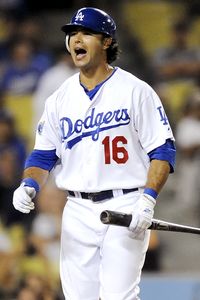
Andre Ethier reacts after Tuesday’s game-ending strikeout.
And then there’s Peter Gammons, whom Vin Scully Is My Homeboy noted last week was thinking out loud about the Red Sox pursuing Ethier.
The one team I keep wondering about if they drop a few games back, if the Dodgers start dropping back, would they talk about Andre Ethier. He’s going to make $10-$12 million next year, the coaching staff feels with their bizarre ownership situation, they don’t want to pay Ethier and might trade him now. That would be a fascinating guy to go after.”
And when Steve Dilbeck of the Times helped spread word of this Tuesday (not to mention Alyssa Milano), more panic.
I’d say there’s no chance of Ethier being traded. If the Dodgers aren’t trading Matt Kemp, they’re not trading Ethier. But let’s say I’m wrong. Let’s say there are bluffs all around and everything and everyone is on Colletti’s table. The Dodgers would be trading Ethier at his highest value. The haul for a 28-year-old All-Star whose work ethic is unquestioned and who won’t be a free agent until November 2012 could be astonishing.
* * *
For that matter, how many teams in baseball would like to have Furcal right now?
No, you’d never trade Furcal now. But six weeks ago, you would have. A slumping, injury-prone shortstop with millions upon millions remaining on his contract? You’d have traded him for less than you’d get for him now.
* * *
I’m talking way too much about trading key players away, but allow me just a little more before I move on.
Four days before the trade deadline four years ago, I wrote a lengthy column for SI.com, advocating that being a seller lose its stigma.
… It should not be so shameful for a .500 team, a team that can only win a World Series if karma and luck fall head over heels in love, to say, “Look, we can be a long shot this year, or we can make a small sacrifice and become a serious contender for years to come.”
Teams can get hot instantly — there’s no denying that. Florida surprised everyone in 2003, went on a run and won the World Series. Houston recovered from a faceplant of a start in 2005 and took the NL pennant. If you’re three games out of the playoffs with a .500 record, the postseason possibilities may be so tantalizing that the slim odds of winning it all may not matter to you.
Good enough. That doesn’t mean it should be a sin to step back and decide that whatever you have now, you can build upon with a little more patience. It should be a choice. And it can be a choice that remains open until the moment the deadline passes, a choice that depends on whether you can get a quality deal or not, as opposed to a deal that just makes you look busy.
As for the fans, some will complain. Some will always complain. But if you show you have a plan and you make an intelligent trade for the future, sacrificing a mere two months in the process could render those complaints moot rather quickly …
I’m not saying the Dodgers should become sellers, and I don’t believe they will become sellers, but there is a case for it. And the funny thing is, the McCourt divorce provides cover for it. Ownership would get crucified by the mainstream for turning 2010 into a rebuilding year. But ownership is already being crucified. So why should we care about the bad PR, if that’s status quo and ultimately the team would be better off for it?
* * *
This website celebrates its eighth anniversary today. After proclaiming my intention to exult or vent as appropriate, my first main post wondered aloud about whether the Dodgers should be sellers.
I guess that temptation has often been with me. Buoyed by the drafts of Logan White, the Dodgers were able to make long-term commitments to developing players from within. But the Dodgers have never taken a similarly long view with regards to midseason trades.
What if they did? I know it will never happen, but what if it did?

Marlon Anderson follows through in the ninth inning, September 18, 2006.
* * *
Then again, does it need to happen? Manny Ramirez in 2008 was a man-made gift from the heavens. And so was Marlon Anderson in 2006.
And 2004, the most tumultuous trade deadline of them all, worked out rather well.
So why not believe? Why not go for it?
Just a week ago, the Dodgers were in fine shape, a good team that was maybe a player or two away from becoming great.
* * *
Roy Oswalt? Jayson Werth? Dan Haren? Ben Sheets? David DeJesus? Scott Downs?
There are some names that could help the Dodgers. But not many.
Dee Gordon? Chris Withrow? Ethan Martin? Jerry Sands? Aaron Miller? Allen Webster? Joe Etc.? Who’s irreplaceable? Who’s gonna make you go, “I don’t miss him that much – so it was worth a shot.”
* * *
You need to be smart, and you need to be fortunate. And you can do that as a buyer or a seller. It truly doesn’t matter which. If you are smart and fortunate, you will win.
The Dodgers won’t be sellers. We can be sure of this. They will either stand pat or acquire someone to help immediately. They might try to acquire someone but end up standing pat because the price was too high. But those are the options.
But the thing is, if you acknowledge that standing pat is a possibility – and that standing pat probably means you won’t win in 2010 (because the teams that rallied from the depths avoided standing pat) – then how can you not entertain the option of trading for the future instead of the present?
If standing pat is a worse choice than selling high, why wouldn’t you be in talks to sell high, as a backup plan?
The answer is one of public relations, of public perception. But this morning, not too many people like the 2010 Dodgers right now anyway. And those that do aren’t the ones who are likely to complain about sacrificing the 2010 Dodgers to make them more competitive in 2011 or 2012.
That’s the paradox.
* * *
Anyway, enough about Plan B. Plan A is to improve the 2010 Dodgers now.
It can be done. Ownership or not. Roy Oswalt’s contract or not. You can make smart trades. The Dodgers have done it before. They can do it again.
Ten days until July 31. Let the freakout begin.
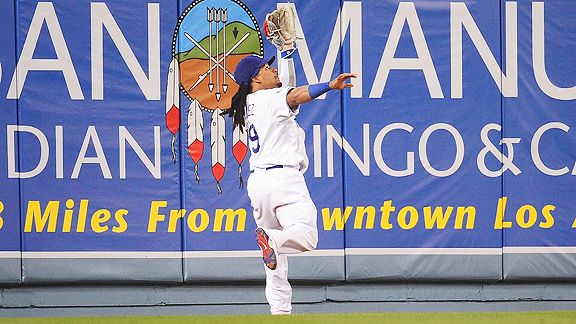
Gary A. Vasquez/US PresswireManny Ramirez and the Dodgers are in the chase, but who’s up for the ride?
One of the most peculiar things to me about last season was how testy many Dodger Thoughts commenters were when things were going well.
For a Dodger team that basically won its division wire-to-wire and had the best record in the National League for almost the entire year, there was an overflow of discontent last spring and summer. The gripes could be rather specific if not downright picayune, but they were constant. Criticism of Joe Torre was ongoing. The war against Matt Kemp batting eighth took on a life of its own. If it wasn’t one thing, it was another.
I pleaded with the unhappy campers to smell the roses, to accept that no team was perfect and enjoy what appeared to be the best Dodger team since at least 1988 (even accounting for Manny Ramirez’s suspension). They told me not to take anything for granted, that success didn’t eliminate the need for worry.
This year, aside from the occasional game like the Sunday night meltdown against the Yankees, things are less angsty in the comments. But weirdly, that seems to speaks to a deeper dissatisfaction in Los Angeles.
It’s just a theory, but I think that in a sense almost everyone felt that last year’s Dodger team was a special team. Or at least might be. Different people absorbed and reacted to this possibility in different ways, but overall the Dodgers’ potential seemed limitless — with even a World Series title possible if they would just not screw it up. People didn’t want to see that team wasted, and that made the stakes higher.
People don’t think this year’s team is a special team. Manny Ramirez is a year older, and Kemp’s spot in the batting order is the least of anyone’s concerns about him. There’s plenty to be happy about, but the team got off to a grim start instead of a great one, and the McCourt saga has sapped that extra bounce from everyone’s step.
Even though the Phillies seem less a threat now than they did a year ago, even though the path to the National League pennant is arguably more wide open than it was a year ago, even though the Dodgers currently sit only a half-game out of a playoff spot … no one seems all that excited.
The one fella that actually seemed to galvanize some fans was John Ely. His burst onto the scene was magical, spreading the kind of fairy dust that, accompanied by a nice month of May, made the eyes of Dodger fans twinkle. But for now, midnight has struck Ely down, and few seem very confident that we’ll make it back to the ball.
I wouldn’t have been writing this piece today if Clayton Kershaw had beaten St. Louis on Thursday, because I don’t think it would have occurred to me to do so after a victory. But I don’t think a victory would have changed the underlying feeling I’m getting. The ennui that seemed to accompany the 7-1 defeat crystallized some thoughts I’ve had percolating for a while.
After 10 or 20 years when Dodgers fans were grateful just to win a single playoff game, that’s no longer enough. They want the World Series. And with but a few exceptions, they don’t think they’re gonna get it.
It’s not that Dodger fans no longer care, or no longer desire. By and large, they just don’t believe.

Getty Images
Celebrate, celebrate, celebrate
But for a blown save on an 0-2 pitch with two out in the ninth inning by Mets closer Francisco Rodriguez at San Diego on Wednesday, the Dodgers would have completed their journey from being in a tie for the worst record in the National League on April 29 to being in a tie for the best today.
Exactly four weeks ago, Dodger fans wondered, “What next?” But it turned out that Murphy’s Law had not become the law of the land – and moreover, the Dodgers showed they could overcome the adversity that remained. This team had a good side after all, and now sits at 31-22, one game from the top of the NL.
Since starting the season 8-14, Los Angeles has gone 23-8. The Dodgers reach the one-third point of the 2010 season tonight on a 95-win pace – exactly the number of games they won last season. And while they had to survive the 50-game suspension of Manny Ramirez and ongoing traumas to Hiroki Kuroda in 2009, this season has been no picnic.
Ramirez, Rafael Furcal and Andre Ethier have been out of the starting lineup a combined 73 times this season, either for injuries or attempts to avoid them, while 2009 postseason stalwart Vicente Padilla has been sidelined since April 22 and four key relievers have been on the suspended, disabled or just plain awful list: Ronald Belisario, Hong-Chih Kuo, Jeff Weaver and George Sherrill.
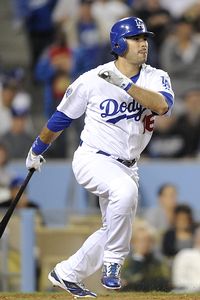
Things haven’t stopped going wrong for the Dodgers – if you needed any more evidence of that, two runs in their past 24 innings against last-place Arizona should suffice. The Dodgers were crazy close to being swept by the Diamondbacks, which would have meant seven losses in their past 10 games, which would have meant another round of Angst Blue Ribbon being passed around the dorm.
Even having avoided that unhappy storm, the Dodgers head into a scheduling tsunami starting this evening. Their opponent for the next four games, Atlanta, has rather amazingly duplicated the Dodgers’ 8-14/23-8 split to take over the NL East lead. This series starts a stretch of 25 games in the remaining 28 days of June for Los Angeles, with the worst opponent in that time being the American League’s 27-28 Angels. Sixteen games this month come against teams on pace to win at least 90 games – the Braves, Cardinals, Reds, Red Sox and Yankees – with the stretch then capped by an out-for-blood rendezvous at San Francisco, playing .633 ball at home.
By July 1, all the doubting and even a good chunk of the loathing from April might return to Chavez Ravine. And no matter how resourceful the Dodgers are, they might find it nearly impossible not to fall farther behind the endlessly underestimated Padres, who get 10 games against the Phillies, Blue Jays and Rays this month but overall have an easier go of it. The Dodgers came within a strike of first place in the NL West on Wednesday; it could be weeks before they’re that close again.
Or not. Because after all, as opposed to a month ago, now the 2010 Dodgers have something more than hope. They now have, if nothing else, an established record of success.
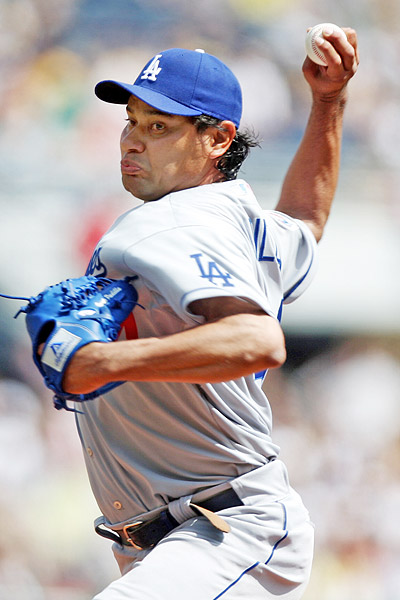
Even without Padilla – some might say especially without him – the Dodgers’ starting rotation of Kuroda, Clayton Kershaw, Chad Billingsley, John Ely and Carlos Monasterios has a combined ERA of 3.08 for the season. Furthermore, all but Monasterios are now regularly pitching six innings or more, putting the Dodgers in position to take advantage of a bullpen that has begun to match last year’s excellence. These guys won’t shut down the opposition each time out. They’ll ebb and flow – Kuroda, the hero of April, is struggling more of late, while Billingsley’s recovery Monday showed signs of a warrior – but in any case, they’ve passed enough tests to inspire confidence. The worst-case scenarios are no longer the only ones anyone can see.
For the time being, the offense has emerged as the greater concern, averaging 2.8 runs in the past 10 games – not exactly Phillies-level slumpage, but poor enough. Still, Dodger fans know the team is capable of better – the 68 runs in the first 10 games of the season, for example, a spiritual facsimile of the 31 consecutive scoreless innings the pitching has just thrown.
In a significant way, the 31-22 Dodgers are in the exact same position the 8-14 Dodgers were in four weeks ago: capable of brilliance, dilapidation and everything in between. At the end of this month, Dodger fans will combine another 25 equations of whether the good outweighed the bad on each and every given day, but right now, not one person can say how it will go. The Dodgers won their past three games thanks to an inexplicable double error and a balk, a seven-inning two-hitter from a guy no one cared about a blink ago, and four innings of shutout relief from their 19th pitcher of the season combined with a by-inches single from a .146 hitter. They won a three-game series with four RBI. That’s as great as it is scary for a team trying to win it all. How do you tell the future from tea leaves so mischievous?
As we move toward the season’s second trimester, perhaps the most salient thought is this. Every single team has its worries, its injuries, its Garret Andersons and George Sherrills, yes, even its hurdles to making a midseason trade. Yes, every single one of them. The Dodgers might have more than some, but not too many yet. A month ago, Dodger fans had reason to doubt whether they’d ever make it into the 2010 pennant race. One thing they can say now: They’re in it.

Getty Images
Stat o’ the Day: Just 27 games into the Dodgers’ 2010 season, Ramon Troncoso has already pitched in 11 losses.
It may be early, but the fans are going wild – and not in a good way.
Wednesday’s 11-3 loss to Milwaukee marked the one-month anniversary of a Dodger season that began with an 11-5 loss to Pittsburgh. Two days shy of one year since Manny Ramirez’s suspension, it’s remarkable to think back and realize: The Dodger community was probably in better spirits that sorry day than now.
The wreckage of the Dodgers’ start to 2010 fits perfectly with the narrative that began in the offseason, which foretold that the divorce of Frank and Jamie McCourt would have a domino effect that would leave the franchise in ruins. And while this isn’t exactly Carthage, it is last place in the National League West in May.
A different ownership situation might have bred a different start to the season, it’s true. No, a pair of happily married McCourts would not have turned the 2009-10 Dodger offseason into a wheeling-and-dealing free-for-all – not after reaching the National League Championship Series two straight years, certainly not after the Jason Schmidt and Andruw Jones debacles of recent offseasons. But Frank and Jamie surely wouldn’t have made fewer moves if they were still going steady.
But what’s sad about the 2010 Dodgers is that the doleful divorce has been only one of many, many, many other things that have gone wrong this season. Here begins “Lament: Why Even in Their Worst Nightmares, the Dodgers Couldn’t Fathom Being This Bad.”
Chapter the First: A Rotation Off Its Axis

Mixed bag: The last 23 batters Chad Billingsley faced Wednesday did not score; the first four did.
Consider, if you will, that the Dodger starting rotation at the end of the 2009 season was made up of Randy Wolf (having something of a career year), a wounded Hiroki Kuroda, a staggering Chad Billingsley, a green Clayton Kershaw, and Vicente Padilla having, well, two great weeks.
Though spring training 2010 began with Wolf in a Milwaukee Brewers uniform, there was every reason to believe that at least 60 percent of that bunch would be better than they were – in contrast to Wolf, who you’d reasonably expect to decline after everything imaginable went right for him at age 33. And in fact, that’s exactly what happened with Kuroda, who has a 2.08 ERA while averaging 6.9 innings per start this year.
But though they have had their moments, Billingsley and Kershaw haven’t exactly been the equivalent of, say, Colorado’s Ubaldo Jimenez, who has pitched 41 1/3 innings with a 0.87 ERA and 44 strikeouts. The growing pains are still evident – more painfully in the case of Billingsley, who is only six months younger than the cherry-picked Jimenez, but more fable-busting for Kershaw, who was supposed to be the guy with the head on his shoulders but instead has walked a mind-boggling seven batters per nine innings in ’09. Both still have bright futures, but the need for more consistency remains. (Tony Jackson of ESPNLosAngeles has more on Billingsley.)
Then there was Padilla, who had two fine starts in the postseason but otherwise had been a forgettable pitcher for most of the past five years or more. The Dodgers chose him in January over Jon Garland, a pitcher they thought enough of five months earlier that they traded infield prospect Tony Abreu for him. The 30-year-old Garland, who signed with San Diego for a guaranteed $5.9 million (including a potential 2011 $600,000 club buyout), has an ERA of 2.06 (adjusted ERA 184) over 35 innings in six starts. The 32-year-old Padilla, who signed with the Dodgers for a guaranteed $5.025 million plus incentives, has pulled a mini-Schmidt: 21 2/3 innings, 6.65 ERA (61 ERA+) and an indefinite stay on the disabled list. This wasn’t the divorce or the budget talking. The Dodgers made a pretty simple either-or choice, and at least to this point, they chose wrong. (And did so even with the character issues that are supposedly so important to Dodger general manager Ned Colletti being in Garland’s favor.)
The fifth spot in the Dodger starting rotation had a number of candidates, though ideally there should only have been two: James McDonald and Scott Elbert. McDonald was the 2008 and 2009 Dodger Minor League Pitcher of the Year who had a rough start in 2010 before finishing the year strong. Elbert is considered by many to be an even brighter prospect. However, neither came close to making any kind of case in spring training that they belonged in the rotation – though they were given little opportunity while manager Joe Torre quickly turned his focus to pitchers who had no more minor-league options, like perennial also-ran Eric Stults and knuckleballer Charlie Haeger, along with a cascade of scrapheap veterans like the Ortiz Unbrothers, Ramon and Russ. Honestly, it was reasonable to suspect that someone from McDonald, Elbert and frenemies could give the Dodgers inconsistent but useful enough output in the back of the rotation – and the Dodgers have certainly had their share of luck in this area in recent years – but it hasn’t come close to happening. That in turn made the Dodgers particularly ill-prepared, at least at this point, for an injury to one of their front four starters, even Padilla.
This brings us back to the four pitchers most talked about this Dodger offseason. One was Wolf, who had a 4.91 ERA after three starts this season but has since allowed two runs in his past 14 innings. Two was John Lackey, who signed a five-year, $82 million contract with the Red Sox and has a 3.89 ERA. Lackey figured to be a B version of the former Dodger with the famous seven-year contract itch, Kevin Brown – not quite as expensive but not quite as good and arguably every bit as likely to get injured for part of his contract. Lackey raises a good question: Do you pay big money for a pitcher even knowing that one of those years he’s likely to spend on the DL? I would have said no – and perhaps that’s ultimately a question for the accountants – but given the Dodgers’ current pitching desperation, many people would probably be inclined to say yes.
Pitchers three and four are Cliff Lee and Roy Halladay, the most-discussed trade targets of the past year. Whatever efforts the Dodgers made to acquire them, the organization has ultimately had to bet that what they had in Kershaw and Billingsley (among other young players) in the long term would be worth more than what they would get out of Lee and Halladay in the short term – not a bad bet, but strictly as of May 2010, a losing bet.
So there you have it. We’ve discussed close to a dozen starting pitchers, and of that group, only Kuroda has given the Dodgers a happy beginning to 2010. Some of the misfortune the Dodgers brought upon themselves; some of it has been ill-fated – but when you add it all up, it’s almost a clean sweep for Murphy’s Law over Los Angeles.
Chapter the Second: The Blahpen
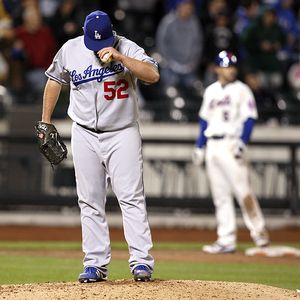
George Sherrill: 0.65 ERA as a Dodger in 2009, 9.00 in 2010.
When your best reliever (Jonathan Broxton) hasn’t even pitched nine innings all year, when your next-best bullpen success story is a Rule 5 draftee (Carlos Monasterios) who remains on the roster, things have gone horribly wrong.
Maybe it all started with Ronald Belisario, for virtually all of spring training trapped in a distant land like a passenger crashing with Oceanic 815, his absence shifting the balance of the bullpen when the season began ever-so-slightly yet ever-so-significantly. His MIA act, accompanied by another ill-timed injury to lefty mesmerizer Hong-Chih Kuo and an almost complete reversal-of-fortune by 2009’s stellar set-up man, George Sherrill, turned a key Dodger strength into a disaster area. In the Dodgers’ first 15 games of 2010, the bullpen lost five – that alone made a huge difference between the Dodgers being 11-16 this morning as opposed to 16-11, of being 5 1/2 games out of first place as opposed to just half a game. And that doesn’t even count games like Wednesday’s, in which the bullpen was handed a one-run deficit and let it multiply by 800%.
What did the Dodgers do wrong with their relievers? Not a lot. Yeah, if money were no object, they could have outbid the Angels for a guy like Fernando Rodney, who signed for an exorbitant amount of money for a reliever: two years, $11 million. Or they could have spent $50,000 on a chaperone for Belisario. Beyond that, what they assembled was battle-tested and looked like one of the best bullpens in baseball. It just hasn’t worked out that way.
Chapter the Third: Defenestrate the defense
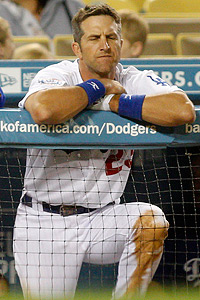
Charged with 10 errors last year, Casey Blake has made half that many this year.
Wednesday, Major League Baseball announced that a change by the official scorer gave James Loney a throwing error for a play that occurred against the Reds nearly two weeks before. It kind of fit: The Dodger defense has been so poor this year that it can pick up errors without even playing.
The defense had actually been on a modest streak of errorless games recently until Wednesday night against the Brewers, when Casey Blake threw in the dirt in the seventh inning of what at the time was a one-run game. Before the night was over, the team botched a rundown play and Blake made another error, his fifth in 24 games.
It felt very familiar. For most of the year, the defense has been toxic. The expected weak spots, such as Ramirez in left field, haven’t even been the story. There have been mistakes all over the field, to the extent that Matt Kemp’s 2009 Gold Glove in center field is being examined for “Dewey Defeats Truman” inaccuracies.
The defense broke the levee on the already cracking Dodger pitching, helping spoil what really was a true onslaught by the Dodger offense in the opening days of the year. The Dodgers averaged 6.5 runs in those first 15 games, but lost eight of them. And yet at seven of eight positions, this was the same defense that the Dodgers took to the NL playoffs last year. The mere aging of players Blake and Ramirez doesn’t begin to explain it. Did the Dodgers not prepare properly in spring training? Who knows? But this was another walk off the cliff that at least in part appeared out of nowhere.
Chapter the Fourth: Yes, Everyone Gets Injuries …
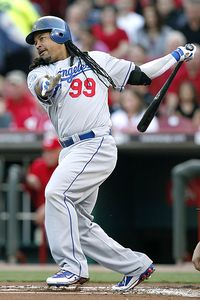
Manny Ramirez has a 1.159 OPS – but only 52 plate appearances.
… so we won’t cry too long over the Dodgers’ sick bay. Losing Kuo was one thing, losing Jeff Weaver was barely anything, but losing Padilla was a problematic thing, and then Ramirez and Rafael Furcal going out almost simultaneously was a big thing. No one expected either Ramirez or Furcal to play 162 games, but in a better Dodger world, they would have at least made it through April. Heck, Ramirez made it into May last year before he was unceremoniously sidelined by what turned up in the lab.
In any case, it’s fair to say that the Dodgers knew in advance they would need a bench this year – and it’s no secret that Colletti has always liked to have depth. But again, some choices that had nothing to do with the divorce have gone awry. For example, on December 16, Jamey Carroll (36 in February) signed with the Dodgers for nearly $4 million over two years. Two weeks later, Kelly Johnson (28 in February) signed a cheaper contract in overall value with Arizona: one year, $2.35 million. Carroll has a .383 on-base percentage but just one extra-base hit. Johnson was just named NL Player of the Month after going 25 for 80 with eight doubles and nine home runs – a .404 on-base percentage and .750 slugging percentage.
Brad Ausmus and Garret Anderson have been wasted signings, albeit relatively inexpensive ones. You’re never going to get ’em all right, and you can certainly argue that so far, Ronnie Belliard has been worth the $825,000 he lost weight to earn from the Dodgers, while Reed Johnson has been what you’d expect him to be. But those are the few breaks the Dodgers have caught, in a first month that exposed another nagging worry sooner than they would have hoped.
Chapter the Fifth: Five months to go
Wednesday, Billingsley gave up four runs in the first inning – then pitched five shutout innings and could have come out battling for a win in the seventh inning had Carroll, well, been able to hit his first three-run homer in 2,574 career plate appearances. Yep, this is when you bring out the unseemly disclaimer: It’s still early.
I haven’t even wanted to mention that the 2009 Colorado Rockies started with an 11-16 record at this time last year, exactly where the Dodgers are today – and then lost 12 of their next 19 before bouncing back with a months-long hot streak that scared the pajamas off every NL rival going into the playoffs. When John Ely, who was something like the Dodgers’ No. 14 starter entering spring training, is the guy you’re counting on for the second week in a row to prevent a series sweep, it’s not auspicious. If Kuroda goes down at some point this year, the Dodgers could give their 91-loss 2005 a run for its worthless money. But yes, it’s still early.
Maybe with happier owners, the Dodgers sign Wolf. Mainly with different owners, the Dodgers splurge for Lackey. Maybe there’s a parallel universe where the Dodgers make the big trade for Lee or convince Halladay that the West Coast ain’t so bad. But the Dodger problems in 2010 have been much more than the loss of one veteran pitcher.
And that’s with some things that people expected to go wrong not doing so at all. Kuroda wasn’t done as a pitcher. Ramirez wasn’t done as a hitter. Broxton has not been scarred by Jimmy Rollins’ game-winning double in the 2009 NLCS. Andre Ethier hasn’t regressed – he’s an early contender for the Triple Crown. James Loney is showing signs of life.
For that matter, Juan Pierre, the supposedly reborn savior from 2009 who was sent to the White Sox for 2010, is batting .226, with seven walks and 15 steals in 19 attempts but no extra-base hits.
It’s still early – but whether it’s early enough for a turnaround or just early in a miserable year, I don’t know. Even for a team playing ball both on the field and in divorce court, so much can change between May and October. After all, look at what’s happened to the Dodgers between October and May.



